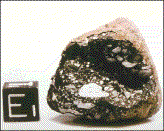| Although the vast majority of large meteorites probably come from the asteroid belt, some are thought to have a different origin. The figure below shows a 0.03-kg meteorite, named ALH81005, which was discovered in the Antarctic ice fields. (The peculiar name results from this being the fifth rock found in 1981 in the Allan Hills region of Antarctica. For scale, the small cube at left is 1 cm wide.) Chemical analysis reveals that the composition of this meteorite differs significantly both from conventional (that is, asteroid-belt) meteorites and from rocks originating on Earth. However, it has many similarities to rocks returned from the lunar highlands by Apollo astronauts.
These lunar meteorites are thought to have been blasted off the Moon's surface by violent impacts long ago: the dozen or so known lunar meteorites seem to have originated in at least six separate events, some perhaps on the Moon's far side. The fragments had enough energy to escape the Moon's gravity and go into orbit around Earth, eventually falling to Earth's surface much like any other meteorite. ALH81005's interior is a jumble of fused rock fragments, just as would be expected if it had been blasted off the lunar surface by some violent event. The small white inclusions evident in the figure match the composition of rocks retrieved from the Moon's highlands. Even more intriguing, scientists now think that a handful of rocks found on Earth may well have come from Mars! (See also Interlude 10-2) Huge impacts millions of years ago, possibly those |
responsible for some of the craters still visible on the Martian surface, have apparently provided us with about 12 free samples of that planet. The second figure shows an 8-kg rock, designated EETA79001, a meteorite found in the Elephantine Moraine region of Antarctica in 1979. (Again, the cube at lower right is 1 cm on a side.)
Although we cannot be certain that this meteorite hails from Mars, the evidence is reasonably strong. First, the relative abundances of some elements, such as nitrogen and argon trapped within the rock, are identical with those in the Martian atmosphere. Second, this meteorite is much younger than most other meteorites—no more than 1.3 billion years old, based on the time since the rock last solidified. (Some of the 12 Mars meteorites are as young as 170 million years.) Finally, like several of the Mars meteorites, EETA79001 has texture suggesting that it formed in lava flows, perhaps like those shown in Figure 10.3(a). The complexity of its rock types—both fine- and coarse-grain lava—suggest that it probably formed in two separate eruptions from the same volcanic event on Mars. Also embedded in the rock are dark veins of shocked glass, likely formed in the impact that blasted it off Mars some 15 million years ago. We are left wondering how many other lunar and Martian rocks now sit on museum shelves and in university labs awaiting proper identification. We can also only speculate if any of the rocks in our own backyards have been blown off alien worlds far, far away. |

